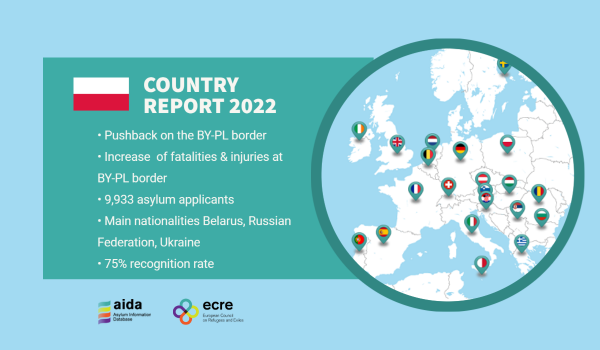The updated AIDA Country Report on Poland provides a detailed overview on legislative and practice-related developments in asylum procedures, reception conditions, detention of asylum seekers, the content of international protection, as well as procedure for and content of temporary protection in 2022.
In 2022, access to the asylum procedure at the Belarusian border remained a major challenge in Poland. According to the Border Guards, in 2022, 12,155 persons were ‘prevented from irregular crossings of the border’ and 2,488 persons were issued an ‘order to leave Poland’. There was an increase in the number of fatalities and persons injured in the forests close to the border area. NGOs also reported an escalation of violence from officers of the Border Guard. Several judgements on the situation at the Belarusian border were issued at the international and domestic levels. Between October 2021 and December 2022, the ECtHR granted nearly 100 interim measures under Rule 39 of the Court’s Rules of Procedure, ordering Polish authorities to refrain from returning the complaining applicants to Belarus, considering that this could constitute a violation of Article 3 of the European Convention on Human Rights.
9,933 people, among whom 2,695 children, presented asylum applications in Poland in 2022. In Terespol, the Border Guards received applications for international protection from 1,029 persons. In the Podlaskie Border Guard Unit (which covered the restricted access border area), another 1,070 applications were registered. The vast majority of asylum applicants (7,137) came from three countries, Belarus, the Russian Federation, and Ukraine, followed by Iraq and Afghanistan. The overall recognition rate stood at 75.5% at first instance.
Various concerns continued to emerge regarding detention conditions, in particular for vulnerable individuals. Children with families are still detained on a regular basis and the best interest of a child is not taken into account in the court proceedings. Additionally, no identification system for victims of violence is in place, and victims of torture are placed in detention centres, where asylum seekers have limited access to psychological assistance.
In the aftermath of the outbreak of war in Ukraine, the response given by Poland was positive in terms of granting access to the territory to people fleeing from the country. In the following months, however, an increasing number of refusals of entry were issued at the Polish-Ukrainian border (14,063 decisions, 11,745 of which towards Ukrainian nationals in the period between March and December 2022), which in some cases hindered the possibility to re-access the EU for people who had already been granted temporary protection.
Two temporary protection mechanisms are currently active in Poland: a general one, arising from the Act on Protection of 2003, and a special one, based on the Special Law adopted in March 2022. Special temporary protection is available only to Ukrainian nationals reached Poland on or after 24 February 2022 and some of their non-Ukrainian family members. General temporary protection applies to other persons deemed eligible for temporary protection under the Temporary Protection Directive. In 2022, there were over 1.5 million special temporary protection beneficiaries. 1,301 persons enjoyed general temporary protection in 2022, with 1,224 beneficiaries as of 31 December 2022. Temporary protection beneficiaries have access to most of the rights provided for in the TPD, but there are differences based on their status as a special or general temporary protection beneficiary.
For further information:
- Find comparative information in the Asylum Information Database (AIDA) managed by ECRE.

